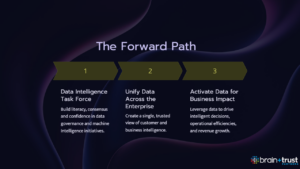The most successful technology implementations aren’t the result of choosing the best vendor—they’re the result of choosing the right vendor for your specific organizational context. Discovery makes that choice possible.
In the rush to modernize and gain competitive advantages, businesses often leap directly to vendor selection for transformative technologies like customer data platforms, marketing automation, cloud services, and AI tools.
This approach, while appearing logical, frequently results in costly misalignments, integration nightmares, and operational disruption.
A comprehensive discovery and diligence process before vendor introduction isn’t just prudent—it’s essential for sustainable business continuity and success.
Two Paths, Different Directions
The Reactive Path: Marketing leadership identifies a customer segmentation challenge, or maybe they were asked diversify revenue with current customers. Within weeks, they’re evaluating three popular customer data platforms, impressed by demos and competitive pricing. Six months and $1.2 million later in time and total contract value (“TCV”), they discover that many existing systems can’t integrate properly, their data governance policies conflict with the platform’s architecture, and their customer service team now operates with completely different customer views than marketing. Worse, they can’t build the audience segments originally sought, and the chosen platform can’t perform as advertised.
The Strategic Path: The same organization conducts thorough enterprise-wide internal discovery first. They map existing data flows, audit current capabilities, assess integration requirements, and understand stakeholder needs and use cases across departments, inviting their agencies and other consultant to provide their perspectives and needs. When they eventually select a CDP, implementation takes much less time, costs 30% less, and delivers measurable ROI within the first quarter.
The Discovery Imperative: Five Critical Dimensions
1. Ecosystem Mapping and Integration Architecture
The Challenge: Modern enterprise businesses operate complex technology ecosystems where new tools must integrate seamlessly with existing infrastructure and often, legacy systems that were not designed for integrations, real-time or otherwise. Without comprehensive mapping, organizations risk creating additional data silos, duplicating functionality, or breaking critical workflows that disrupt operational continuity.
Discovery Requirements:
- A complete audit of current technology stack and data architecture
- Documentation of existing APIs (and those connectors lacking), data formats, and integration patterns
- Assessment of security requirements and compliance obligations
- Identification of potential integration conflicts and dependencies
Real-World Impact: Companies avoid costly implementation failures by discovering which systems work well together and those that require custom connectors, unique data transfer protocols and/or extensive data engineering.
2. Stakeholder Needs Analysis and Change Management
The Challenge: Technology decisions made in isolation often fail to address the actual needs of end users across the organization. Different business units and operational departments may have conflicting requirements or workflows that vendors don’t immediately understand.
Discovery Requirements:
- Cross-functional stakeholder interviews and needs assessments
- Current state workflow documentation and “pain point” identification
- Use case aspirations discussed, future state envisioned and requirements prioritized
- Change management readiness evaluated and contingencies mapped for reskilling current talent and/or hiring additional/replacement talent (Automation and AI can be liberating, and consequential).
Business Value: Organizations that conduct thorough stakeholder analysis report much higher user adoption rates and faster time-to-value for new technology implementations.
3. Data Governance and Privacy Compliance
The Challenge: Customer data platforms, generative and applied AI tools, and marketing automation systems handle sensitive information that must comply with GDPR, CCPA, TDPSA, industry regulations (such as HIPAA), FTC Rules, and internal governance policies. Compliance failures can result in massive fines, disruption of operations, and reputation damage.
Discovery Requirements:
- Data classification and sensitivity mapping
- Current privacy policy and consent management assessment
- Regulatory compliance gap analysis
- Data residency and sovereignty requirements
- Audit trail and accountability framework evaluation
Risk Mitigation: Proper discovery helps avoid the hundreds of millions in fines that poorly implemented data platforms have triggered for companies with inadequate privacy controls.
4. Security and Risk Assessment
The Challenge: Introducing new vendors creates additional attack surfaces and potential security vulnerabilities, and the daily proliferation of public LLM use, open source AI models, and AI services compounds the volume of threats facing business today. More than ever, AI tools and cloud-based SaaS platforms require careful security evaluation to protect against data breaches and system compromises.
Discovery Requirements:
- Security architecture review and threat modeling (yes, modeling. We have agents for this!)
- Vendor security assessment framework development
- Access control and authentication requirements defined
- Data encryption and transmission security evaluation
- Incident response and business continuity planning
Security ROI: Organizations with thorough pre-vendor security discovery report 70% fewer security incidents and 45% lower remediation costs compared to reactive security approaches.
5. Financial and Operational Due Diligence
The Challenge: The total cost of ownership for enterprise software extends far beyond licensing fees. Hidden costs in implementation, training, maintenance, and operational overhead can triple initial budgets.
Discovery Requirements:
- Total cost of ownership modeling and budget planning
- Resource requirement assessment and capacity planning
- Vendor financial stability and long-term viability analysis
- Vendor references and experience
- Contract terms and exit strategy evaluation
- ROI measurement framework development – how will success be measured?
The Strategic Framework: Four-Phase* Discovery Process
Phase 1: Current State Assessment (2 weeks)
Comprehensive audit of existing capabilities, technology stack, processes, and organizational readiness. This phase establishes the baseline and identifies critical constraints and requirements.
Phase 2: Future State Visioning (1-2 weeks)
Collaborative sessions with stakeholders to define desired outcomes, success metrics, and operational vision. This phase ensures alignment between business objectives and technology capabilities.
Phase 3: Gap Analysis and Requirements Definition (2 weeks)
Detailed analysis of the differences between current and future states, resulting in precise functional and non-functional requirements for vendor evaluation.
Phase 4: Vendor Strategy and Selection Framework (2-3 weeks)
Development of evaluation criteria, scoring methodologies, and selection processes that align with discovered requirements and organizational constraints.
*Phases 1-3 may overlap and/or be concurrently executed.
Quantifying the Discovery Investment
The Typical BrainTrust Partners Discovery is: $10,000 – $50,000 depending on organizational complexity and scope.
Avoided Costs Through Discovery:
- 40-60% reduction in implementation costs
- 50-70% decrease in post-implementation changes and fixes
- 30-45% faster time-to-value achievement
- 60-80% reduction in user adoption challenges
- 70-90% fewer compliance and security incidents
Net ROI: Organizations typically see 300-500% return on discovery investments through avoided costs and accelerated value realization.
The Competitive Advantage of Thorough Discovery
Organizations that prioritize discovery before vendor introduction consistently demonstrate:
Operational Excellence: Smoother implementations, higher user adoption, and better integration with existing processes
Financial Efficiency: Lower total cost of ownership, reduced implementation risk, and better ROI achievement
Strategic Agility: Faster adaptation to changing business needs and more effective technology decision-making
Risk Mitigation: Fewer compliance issues, security incidents, and operational disruptions
Discovery as Strategic Investment
In an era where technology decisions can make or break your competitive advantage, perseverance, and future growth, thorough enterprise discovery isn’t an optional preliminary step—it’s a strategic imperative. Organizations that will confidently navigate the next 3-5 years are those that understand that the path to successful operations begins not with vendor selection, but with deep understanding of their own capabilities, internal and customer needs, and constraints.
The question isn’t whether you can afford to invest in comprehensive discovery.
The question is whether you can afford not to.







